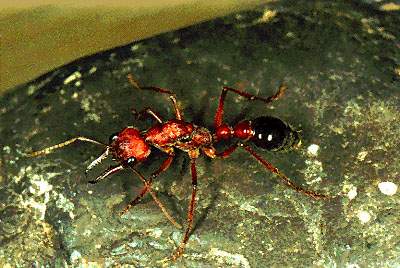
Order
HYMENOPTERA(Greek, hymen = membrane; pteron = wing)
Common Names
sawflies, wasps, bees, ants
Description
This order contains at least 100,000 species as wood wasps, sawflies, wasps, bees and ants. All members have compound eyes and simple eyes (ocelli) may be present. Chewing mandibles are always present and may be used for sucking and chewing or holding and killing prey. Antennae are long, prominent and usually composed of short, straight segments (filiform). Typically, hymenopterans are "narrow waisted": the abdomen is attached to the thorax by a strongly constricted segment. If wings are present, both pairs are finely veined and the fore and rear wings of each side are attached along their adjacent edges by a row of hooks (hamuli) to form a single flying surface. All members have an ovipositor (a tube allowing the female to deposit eggs) but in the bees, wasps and ants this is frequently modified to form a venom tube or sting. Adults may feed on nectar, pollen and honeydew but specialised species may use seeds, fungi, etc. Many are carnivorous on other insects and may exhibit parasitism.
Life Cycle
The hymenopteran life cycle involves metamorphosis of egg-larva-pupa-adult. Insects may be solitary or social, with community development in the ants and honey bees where only a single female (the queen) is sexually mature. Most bees are restricted to nectar, pollen and honeydews. These foods are consumed by larvae and adults with the exception that in the honey bee (Apis mellifera), the larvae are selectively fed bee secretions (royal jelly) in order to determine whether a female larva will become a reproductive adult female.
Food
Wasps and hornets usually use a variety of arthropods as food for their larvae including spiders, flies, cicadas, etc. The wingless females of the "Blue Ant" wasp (Diamma bicolor) burrow into the soil and hunt mole crickets in order to parasitise them. The minute chalcid wasps specialise in parasitising insect eggs. Sawfly larvae cluster on food trees and can defoliate the branches when large numbers are present.
Importance
The honey bee provides honey and bee's wax which is worth millions of dollars yearly. Of even greater value is the pollination of crops: fruits, seeds, timber, etc. and some contribution is made by the small Australian native bees (Trigona spp.). The wasps are extremely important in natural control of insect pests and several species are already in wide use as biological control agents.

